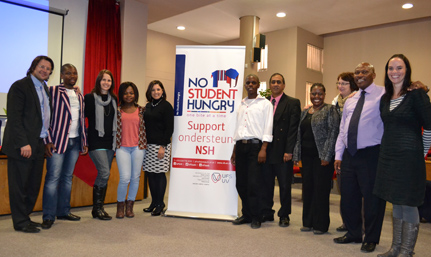|
 |
Samkelo Duma (white shirt) flanked by some of the guests during the launch of the NSH Programme on the Qwaqwa Campus.
Photo: Thabo Kessah
02 May 2013 |
The Qwaqwa Campus of the University of the Free State launched the No Student Hungry (NSH) Programme on Friday 26 April 2013. The programme aims to provide needy students with a daily balanced meal to enable them to concentrate in class and ultimately obtain their degrees. The programme – initiated by Vice-Chancellor and Rector Prof Jonathan Jansen in 2011 on the Bloemfontein Campus – already feeds hundreds of students.
Rudi Buys, Dean of Student Affairs who represented the Rectorate, encouraged students in need to focus more on their desire for greatness.
“Through this programme, you will be able you to shift your focus from the hunger pangs and rather focus all your energy on the hunger to make Africa great,” said Buys. “We want you to be different from the rest of your generation that is reluctant to compete for greatness. Many of your peers prefer mediocrity and it is our wish that through this programme, you can start learning to compete with the best,” Buys impelled.
According to the Qwaqwa Campus programme co-coordinator, Selloane Phoofolo, NSH operates on a primary and a secondary level.
“The primary level offers a food bursary to the students whose academic performance is above 65 percent and not receiving any form of financial assistance. For the 2013 academic year, we had 53 students applying and 31 have qualified. They are getting a meal for R25.00 a day at the Dining Hall,” said Phoofolo.
She further explained that, “On the secondary level, we provide monthly food parcels to 19 students who did not qualify for the food bursary. These food parcels are donated by Pick n Pay and Stop Hunger Now SA. For this, beneficiaries must undertake 40 hours of community service during the year. They must also partake in student activities. Their academic progress is monitored by the Office of Social Work.”
One of the beneficiaries, a final-year BA degree student Samkelo Duma, expressed his gratitude towards the UFS for giving him an equal opportunity to those in more fortunate situations to do his best in his studies. “It is difficult to study and concentrate on an empty stomach and I must say that the NSH is very helpful. I do not just get a meal, but I get a healthy meal to keep me going throughout the tough day,” Duma said.
Also present at the launch were the patrons of the programme, Ms Grace Jansen and Dr Carin Buys. They volunteer their time and energy to raise funds for the project.
Students apply for the allowances and are selected on the basis of financial need, academic results, active participation in student life programmes and commitment to give something back to the community.
You can also invest in these students' future by contributing R10.00 each time you sms the word 'Answer' to 38722.